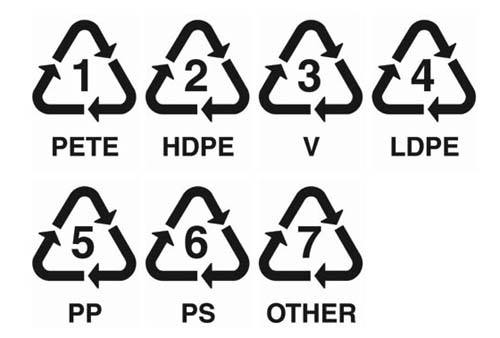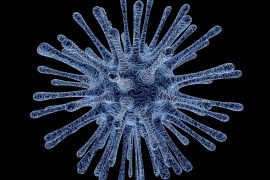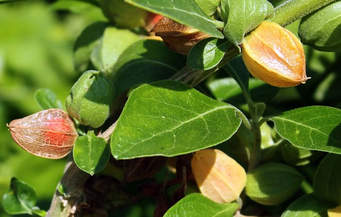Plastic is part of modern living. Many of the products we use in our homes or the foods we consume are in plastic containers. Whether its shampoo bottles, plastic wrap, detergent bottles or food storage containers, just about every home has plastic. From a health point of view, it’s the leaching of chemicals into our food and water that is of great concern. The negative effects of plastics are related to a number of health issues such as: type 2 diabetes, heart disease, impaired brain development, obesity, as well as prostate and breast cancer and hormonal imbalances.
So what exactly does each number mean?
Plastic containers and bottles have a number on the bottom, ranging from 1 to 7 within a triangle shape. These numbers are actually very helpful in determining what chemicals were used in making the product, if it will leach into the product and how long it will take to break down.
#1-PETE or PET (Polyethylene Terephthalate)-This plastic is usually found in clear containers such as water bottles, soda bottles, salad dressing bottles and nut butter containers.
This plastic can be recycled into furniture, tote bags, carpeting, paneling, fiber and even polar fleece.
Concern: This plastic is meant for one time use only, due to bacterial build up. Studies have also found antimony (a contaminant that causes acute and chronic health effects), leaching from the plastic into water bottles.
#2-HDPE (High Density Polyethylene)-This opaque plastic is usually used for household cleaners, milk jugs, juice bottles, shampoo containers, liners for cereal boxes, butter tubs and toiletry bottles.
This plastic can be recycled into recycling containers, lumber, benches, fencing, picnic tables and detergent bottles.
Concern: No known health concerns at this time.
#3 V or PVC (Vinyl)-This plastic is used in a wide range of products from cling wrap, air mattresses, toys, shampoo bottles, cooking oil bottles, medical equipment, detergent bottles, clear food packaging and plumbing pipes. This type of plastic can contain phthalates, which are linked to numerous health problems.
This plastic can be recycled into roadway gutters, paneling, flooring and decks.
Concern: PVC is a toxic plastic that should be avoided. Vinyl chloride, the chemical used to make PVC, is a known human carcinogen, according to the World Health Organization’s International Agency for Research on Cancer (IARC).
4-LDPE (Low Density Polyethlene)- LDPE is often found in carpeting, clothing, squeezable bottles, shopping bags, frozen food bags, bread bags, and some food wraps.
This plastic can be recycled into paneling, trash can liners and cans, compost bins, floor tiles, and shipping envelopes.
Concern: No known health concerns at this time.
#5 – PP (Polypropylene)-This plastic is used in yogurt containers, medicine bottles, ketchup and syrup bottles.
Polypropylene can be recycled into bicycle racks, signal lights, brooms, bins, auto battery cases, pallets microwaveable containers and ice scrapers.
Concern: PP is microwave safe, which simply means it won’t warp or melt when heated. Food should be heated in glass containers, not PP.
#6 – PS (Polystyrene) Also known as Styrofoam, is used in egg cartons, disposable cups and plates.
It can be recycled into insulation, egg cartons, foam packing and packing peanuts.
Concern: According to the Foundation for Achievements in Science and Education fact sheet, long term exposure to small quantities of styrene can cause neurotoxic (fatigue, nervousness, difficulty sleeping), hematological (low platelet and hemoglobin values), cytogenetic (chromosomal and lymphatic abnormalities), and carcinogenic effects. Styrene is classified as a possible human carcinogen by the EPA and by the International Agency for Research on Cancer (IARC).
#7 – Other, Miscellaneous-Any plastics that don’t fit into the above categories are placed in category #7. This mix of plastics can include polycarbonate, which contains toxic bisphenol-A (BPA). This plastic is found in large gallon water storage bottles, computer cases, sunglasses, iPod cases and bullet proof materials.
It can be recycled into plastic lumber and other custom-made products.
Concern: BPA lined containers can leach into food and drinks. BPA is a known endocrine disruptor.
So what’s safe and what’s not?
2, 4, and 5 are currently considered to be the safest for human use.
3, 6 and 7 are best to avoid.
1 is considered safe, but isn’t designed for re-use due to bacterial build up.
Considerations
Due to the health risks it is best to avoid the use of plastics whenever possible. Consider these options:
Replace plastic bottles with glass or stainless steel bottles.
Use glass storage containers in place of plastic.
Repackage cereals, grains, pastas in glass containers.
When buying in bulk at the store, bring your own glass containers. (Weigh them before filling)
If you must use plastics, avoid exposing them to high heat from your dishwasher or microwave, wash with mild detergents by hand.
Work on gradually replacing your plastics with glass containers whenever possible.








